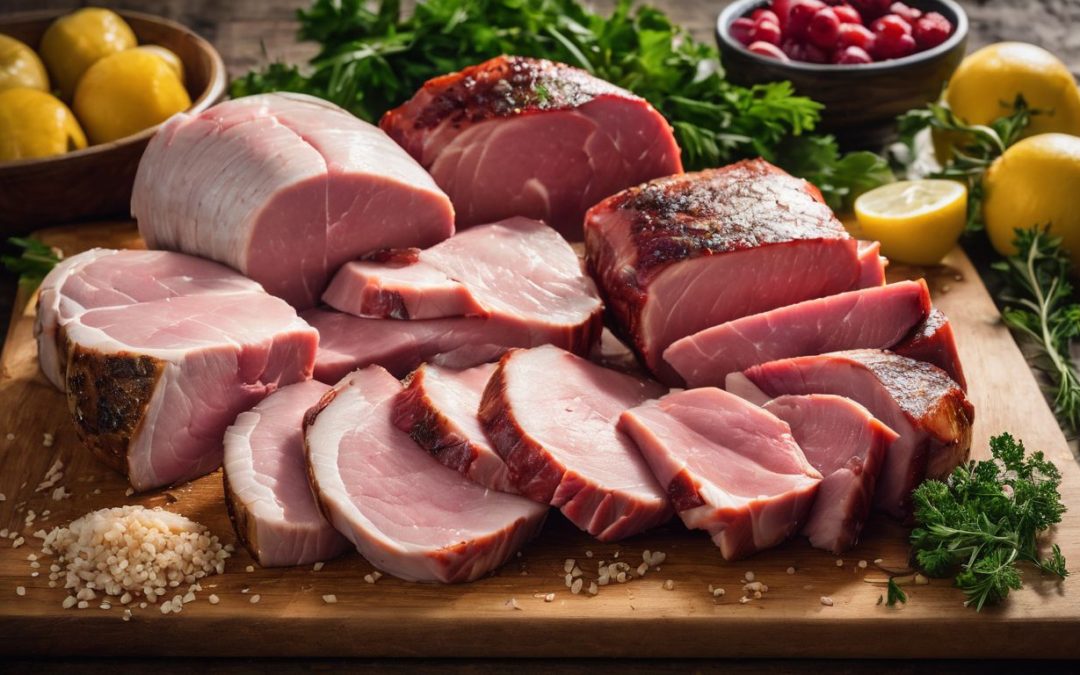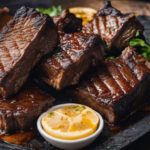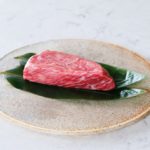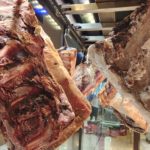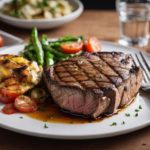Feeling overwhelmed about the many cuts of pork at your local butcher shop? You’re not alone. Pork, with its primal cuts including shoulder, loin, belly and leg, offers an array of options that can be confusing to anyone.
Fortunately, this article serves as a guide – breaking down key information from tenderloin to rib chops and simplifying these complex terms for you. Ready to become a pork cut expert? Keep reading!
Key Takeaways
- Pork has several primal cuts, including shoulder, butt, loin, leg, and side.
- The shoulder offers cuts like pork butt and picnic shoulder that are great for slow cooking.
- The loin gives us delicious cuts like pork chops and pork tenderloin that are best cooked using dry heat methods like grilling or roasting.
- The leg provides cuts like ham and ham hock that can be cooked in various ways for juicy meat.
- The side or belly is where bacon comes from and can be cured or braised for different dishes.
- Popular cuts of pork include pork loin chops, rib chops, pork tenderloin, baby back pork ribs, center cut loin roast, bacon, and St. Louis style spare ribs.
- Each cut has its own unique characteristics in terms of taste and tenderness.
- Different cooking methods work best for each cut: slow cooking/braising for the shoulder; grilling/pan-frying for the chops; roasting/grilling for the tenderloin; smoking/baking for the ribs; pan-frying/baking for bacon; roasting/barbecuing/baking for the center-cut loin roast and St. Louis style spare ribs.
Primal Cuts of Pork
The shoulder, butt, loin, leg, and side are the main primal cuts of pork.
Shoulder
The shoulder of a pig gives us tasty cuts. This part is one of the four main parts known as primal cuts. The cuts from the shoulder we can eat are called pork butt and picnic shoulder.
These are good for slow cooking. They give us juicy meat that falls off the bone. It’s perfect for pulled pork or stewed dishes!
Butt
The butt is one of the primal cuts of pork, found in the shoulder area. It includes the pork butt and picnic shoulder cuts. The pork butt is a versatile cut that’s great for slow cooking and smoking.
It has lots of marbling, which makes it juicy and flavorful when cooked low and slow. The picnic shoulder is another cut from the butt that can be roasted or braised for tender, succulent meat.
Whether you’re making pulled pork sandwiches or hearty stews, the butt cuts are perfect for deliciously tender dishes.
Loin
The loin is a very important part of the pig because it gives us delicious cuts like pork chops, pork tenderloin, and pork loin. These cuts come from the area that runs from the hip to the shoulder and includes the tenderloin.
The tenderloin is a long, thin muscle that comes from inside the rib cage. It’s also known as pork fillet. When you’re cooking these cuts, it’s best to use dry heat methods like grilling or roasting to bring out their juicy flavor.
So next time you’re at the market, look for some tasty cuts from the loin section!
Leg
The leg is a primal cut of pork that includes cuts like ham and ham hock. It’s a flavorful and versatile part of the pig that can be cooked in various ways. If you’re looking for a tender and juicy option, try cooking a ham roast or using sliced ham for sandwiches.
Ham hocks are perfect for adding depth to soups, stews, and beans. The leg is full of delicious meat that will satisfy any meat lover’s cravings!
Side
The side, also known as the belly, is a primal cut of pork that gives us delicious and versatile cuts like bacon and pork belly. The side is fatty and has layers of meat and fat running through it, making it perfect for curing or braising.
Bacon, which comes from the side, is a popular choice for breakfast or adding flavor to various dishes. Pork belly can be roasted or cooked slowly until tender and crispy on the outside.
Its rich flavor makes it a favorite in many Asian cuisines. Whether you’re looking for crispy bacon or succulent pork belly, the side offers plenty of options to satisfy your meat cravings.
Popular Cuts of Pork
Some popular cuts of pork include pork loin chops, rib chops, pork tenderloin, baby back pork ribs, center cut loin roast, bacon, and St. Louis style spare ribs.
Pork Loin Chops
Pork loin chops are delicious and tender cuts of meat that come from the loin primal cut of the pig. The loin runs along the back, from the hip to the shoulder, and includes the tenderloin.
These chops are bone-in and have a nice layer of fat around them, which adds flavor and juiciness when cooked. They can be grilled, pan-fried, or baked in the oven. Pork loin chops have a mild flavor that pairs well with various herbs and spices.
They cook quickly and should be cooked to an internal temperature of 145°F for optimal safety and tenderness. So if you’re craving a juicy and flavorful pork chop, look no further than the pork loin chop!
Rib Chops
Rib chops are a delicious and juicy cut of pork that comes from the rib section of the pig. They are known for their rich flavor and tenderness, making them a favorite among meat lovers.
Rib chops are bone-in cuts, which adds extra flavor during cooking. They can be cooked on the grill, in the oven, or even pan-fried for a quick meal. The fat marbling in rib chops keeps them moist and flavorful, and they’re perfect for seasoning with your favorite herbs and spices.
Whether you prefer them grilled to perfection or seared in a hot pan, rib chops are sure to satisfy your craving for a tasty pork dish. Enjoy these succulent cuts with mashed potatoes or roasted vegetables for a satisfying meal any day of the week!
Pork Tenderloin
Pork tenderloin, also known as pork fillet, comes from the topside of the pig. It’s a long, thin muscle that is located inside the rib cage. This cut of pork is very lean and tender, making it perfect for quick cooking methods like grilling or pan-searing.
Pork tenderloin has a mild flavor that pairs well with various seasonings and marinades. It can be seasoned with simple herbs and spices or marinated in a flavorful sauce to enhance its taste.
Whether you’re cooking for a weeknight dinner or hosting a special gathering, pork tenderloin is a versatile and delicious option to consider.
Baby Back Pork Ribs
Baby back pork ribs are a popular cut of meat that come from the loin section of the pig. These ribs are known for their tenderness and delicious flavor. They get their name because they are smaller in size compared to other rib cuts.
Baby back pork ribs have less fat than spare ribs, making them leaner and healthier. They are great for grilling or smoking, as they cook quickly and retain their juiciness. You can season them with your favorite barbecue rub or marinade to enhance the taste.
Whether you enjoy them at a summer cookout or a cozy winter meal, baby back pork ribs are sure to satisfy any meat lover’s appetite!
Center Cut Loin Roast
The center cut loin roast is a delicious and tender cut of pork that comes from the loin primal section. It’s sometimes called the “center-cut chop” or “pork roast.” This cut is taken from the center of the whole loin, which means it has less fat compared to other cuts.
The center cut loin roast is known for its amazing flavor and tenderness. It’s perfect for roasting in the oven or on the grill, and it can be seasoned with your favorite herbs and spices.
Whether you’re hosting a special dinner or simply want to treat yourself, the center cut loin roast is an excellent choice for meat lovers who crave juicy and flavorful pork.
Bacon
Bacon is one of the most popular cuts of pork, and for good reason! It comes from the side or belly of the pig, and it’s known for its deliciously salty and smoky flavor. Bacon can be enjoyed in many different ways – you can fry it up crispy and eat it on its own, use it as a topping for burgers or salads, or add it to dishes like pasta carbonara.
It’s important to note that there are different types of bacon available, such as cured bacon (which has been treated with salt and other seasonings) and uncured bacon (which is typically labeled as “natural”).
No matter which type you choose, bacon adds a wonderful savory touch to any meal. So go ahead and savor those crispy strips – everything really is better with bacon!
St. Louis Style Spare Ribs
St. Louis Style Spare Ribs are a popular cut of pork, known for their delicious flavor and tender meat. These ribs come from the belly area of the pig, specifically from the rib section.
They are larger and meatier than baby back ribs, making them perfect for those who love to sink their teeth into juicy, succulent meat. St. Louis Style Spare Ribs are often seasoned with dry rubs or marinades before being slow-cooked on a grill or in an oven.
The result is tasty, fall-off-the-bone goodness that is sure to satisfy any BBQ lover’s cravings.
Exploring Each Cut
Now let’s dive into the delicious details of each cut – from juicy pork loin chops to mouthwatering baby back ribs. You don’t want to miss this meaty exploration!
Descriptions and characteristics of each cut
The different cuts of pork each have their own unique descriptions and characteristics. The shoulder is a primal cut that includes cuts like pork butt and picnic shoulder. It’s a flavorful and fatty cut that is great for slow cooking or braising.
The loin, another primal cut, includes cuts like pork chops, pork tenderloin, and pork loin. These cuts are leaner and can be grilled or pan-fried for a delicious meal. The side/belly is where bacon comes from and is known for its rich flavor and high fat content.
The leg, which includes ham and ham hock, is a tough but flavorful cut that benefits from long cooking times to become tender. Understanding these different cuts will help you choose the right one for your recipe!
Best cooking methods for each cut
Here are the best cooking methods for each cut of pork:
- Pork shoulder:
- Slow cooking: Braising or roasting at low temperatures for tender, flavorful meat.
- Pulled pork: Slow-cooked and shredded for sandwiches or tacos.
- Pork chops:
- Grilling: Cook over medium-high heat to get a nice char while keeping them juicy.
- Pan-frying: Sear on both sides in a hot skillet, then finish in the oven to ensure even cooking.
- Pork tenderloin:
- Roasting: Cook in the oven at high heat for a short time to keep it tender and juicy.
- Grilling: Sear quickly over direct heat, then move to indirect heat to finish cooking.
- Baby back pork ribs:
- Slow smoking: Use low temperature and smoke for several hours until they’re fall-off-the-bone tender.
- Oven baking: Wrap in foil and bake at a low temperature for a few hours until they’re tender.
- Bacon:
- Pan-frying: Cook strips over medium heat until crispy and delicious.
- Baking: Arrange slices on a baking sheet and cook in the oven until crispy.
- Center-cut loin roast:
- Roasting: Cook in the oven at moderate heat, allowing it to develop a golden crust while staying moist inside.
- St. Louis style spare ribs:
- Low and slow barbecuing: Smoke at low temperatures for several hours until tender and flavorful.
- Oven baking: Precook with dry rub, then bake covered with foil at low temperature before finishing with sauce under high heat.
Flavor profiles of each cut
Each cut of pork has its own unique flavor profile. The shoulder cuts, like the pork butt and picnic shoulder, are known for their rich, savory taste. They have a good amount of fat marbling that gives them a juicy and flavorful bite.
Moving on to the loin cuts, such as pork chops and pork tenderloin, they have a slightly milder taste with hints of sweetness. These cuts are leaner than the shoulder cuts but still tender and delicious when cooked properly.
When it comes to ribs, both baby back ribs and spare ribs offer smoky flavors with a nice balance of meatiness and tenderness. Lastly, bacon is famous for its salty and smoky flavor that adds depth to any dish it’s used in.
Tips for Choosing and Cooking Pork Cuts
Choose cuts of pork with marbling for extra flavor and tenderness. When cooking, use high heat methods like grilling or pan-searing for lean cuts, and low and slow methods like braising or roasting for tougher cuts to break down the collagen fibers.
Pair different marinades and spices with each cut to enhance their unique flavors.
How to select the best cuts at the market
To choose the best cuts of pork at the market, keep these tips in mind:
- Look for marbling: Marbling refers to the small streaks of fat within the meat. More marbling means more flavor and tenderness.
- Check for color: Fresh pork should be pinkish-red in color. Avoid any meat that appears gray or has a dull color.
- Consider thickness: Choose cuts that are consistent in thickness for even cooking. Thicker cuts are ideal for grilling or roasting, while thinner cuts work well for quick cooking methods like sautéing.
- Inspect the texture: The meat should feel firm, yet slightly springy to the touch. Avoid any cuts that feel too soft or mushy.
- Assess freshness: Check the sell-by date on packaged pork or ask your butcher about its freshness if buying from a counter. Fresh pork should have a clean smell and not have any off odors.
- Ask your butcher: Don’t hesitate to ask your butcher for recommendations and guidance on selecting the best cuts of pork based on your cooking preferences.
Recommended cooking techniques for different cuts
Cooking pork cuts requires different techniques to bring out their best flavors and textures. Here are some recommended cooking techniques for different cuts of pork:
- Pork Chops: Sear them in a hot pan for a few minutes on each side, then finish cooking in the oven or grill.
- Pork Tenderloin: Roast it in the oven at high heat or grill it over medium-high heat until cooked through.
- Baby Back Ribs: Slow cook them on low heat in the oven or grill, using a flavorful marinade or dry rub.
- Center Cut Loin Roast: Roast it in the oven at a lower temperature until it reaches an internal temperature of 145°F (63°C).
- Bacon: Cook it in a skillet over medium heat until crispy and browned, then drain excess fat on paper towels.
- St. Louis Style Spare Ribs: Slow cook them on low heat with a tangy barbecue sauce until tender.
Suggestions for flavor pairings and marinades
Enhance the flavor of your favorite pork cuts with these delicious suggestions for pairing and marinades:
- Pork Chops:
- Season with a blend of garlic, rosemary, and thyme for a classic herb – infused taste.
- Give them a sweet and tangy twist by marinating in a mixture of honey, mustard, and apple cider vinegar.
- Pork Tenderloin:
- Enjoy the tenderloin’s natural flavor by brushing it with olive oil and sprinkling on salt and pepper before grilling.
- For an Asian – inspired dish, marinate in a soy sauce, ginger, and sesame oil mixture.
- Baby Back Pork Ribs:
- Create mouthwatering barbecue ribs by slathering them in a smoky and spicy dry rub.
- Slow cook ribs in a marinade of brown sugar, ketchup, Worcestershire sauce, and spices for tender fall-off-the-bone goodness.
- Bacon:
- Enhance the savory taste of bacon by adding a sprinkle of black pepper or paprika before cooking.
- For a sweet-savory combo: brush slices with maple syrup or honey while cooking.
Conclusion
In conclusion, understanding the different cuts of pork can help you choose the right one for your cooking needs. From tenderloin to rib chops, each cut has its own unique characteristics and flavors.
Whether you’re grilling, roasting, or frying, knowing which cut to use will ensure a delicious meal every time. So next time you’re at the market, don’t be shy to ask your butcher about the various pork cuts available and explore new flavors in your kitchen!
FAQs
1. What is the difference between tenderloin and rib chops?
The main difference between tenderloin and rib chops is their location on the pig – tenderloin comes from the loin area, while rib chops come from the ribs.
2. How should I cook tenderloin versus rib chops?
Tenderloin is best cooked quickly at high heat, such as grilling or pan-searing, while rib chops can be cooked using various methods like grilling, roasting, or broiling.
3. Are there any other cuts of pork besides tenderloin and rib chops?
Yes, there are many other cuts of pork including shoulder (also called pork butt), bacon, ham, pork belly, and spare ribs to name a few.
4. Which cut of pork is the most tender?
Tenderloin is considered one of the most tender cuts of pork due to its location on the pig and low fat content.
Greetings!
With over two decades of diverse experience in the meat industry, I proudly stand as an expert in all things meat. My journey commenced with a strong foundation in hospitality, where I honed my culinary skills as a chef in prestigious restaurants and on luxurious superyachts worldwide.
However, my true passion lies in the art of butchery. Throughout my extensive career, I have had the privilege of working with renowned meat purveyors and mastering the craft of meat cutting and preparation. From breaking down whole carcasses to meticulously selecting prime cuts, my butchery expertise is at the core of my meat knowledge.
Having immersed myself in various cultures and cuisines, I have honed my skills to deliver exceptional dining experiences, crafting delectable dishes that celebrate the natural flavors of different meats. Whether it's sourcing the finest meats for discerning clients or sharing valuable tips on meat selection and cooking, I take pride in elevating the meat experience for both professionals and enthusiasts.
My journey has taken me from the bustling kitchens of top-rated restaurants to the heart of meat processing facilities, gaining insights and honing my skills to become a true meat connoisseur. Now, I am enthusiastic about sharing my expertise, offering valuable insights on meat selection, cooking techniques, and the art of butchery.

